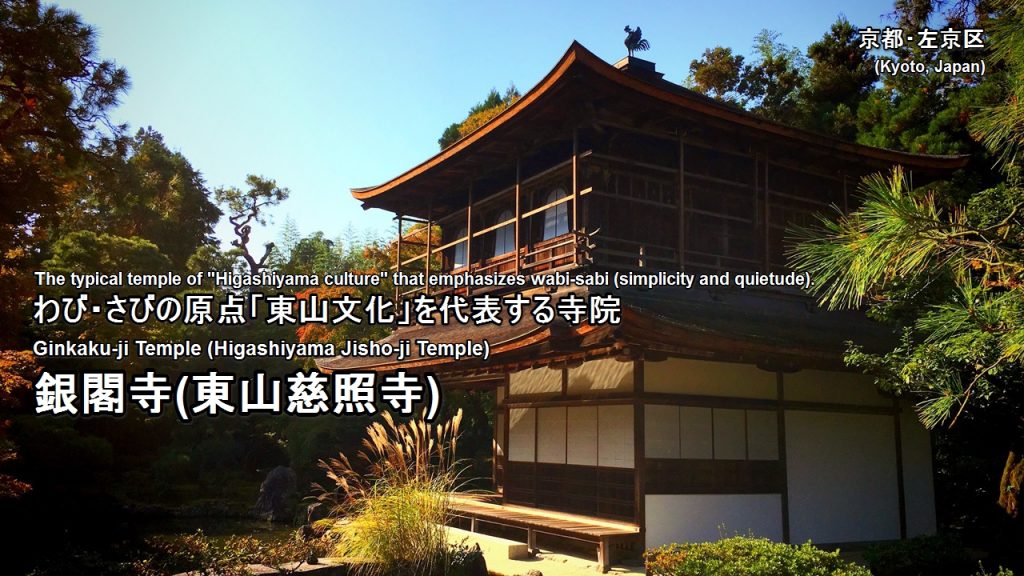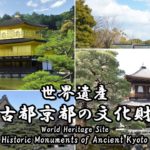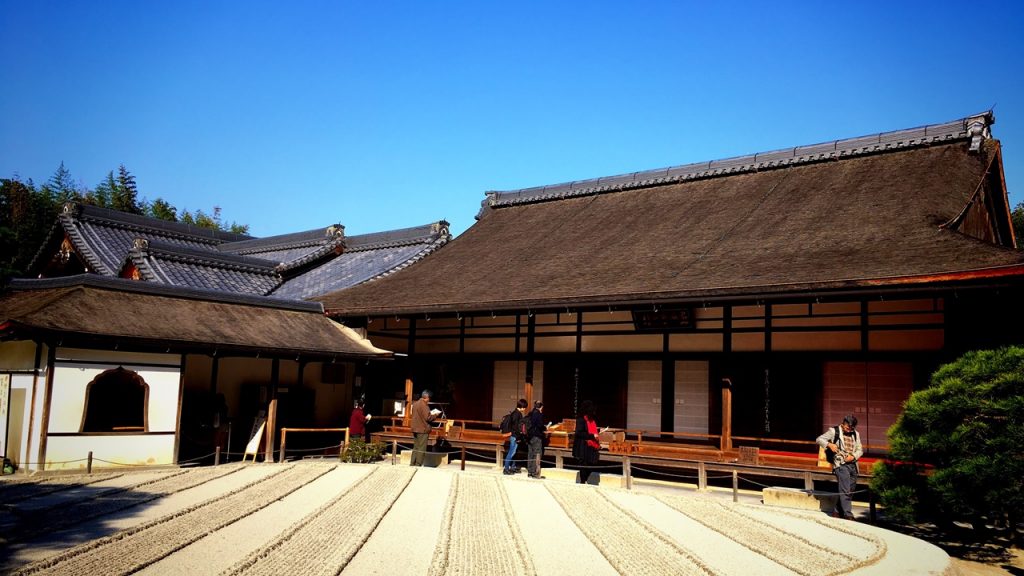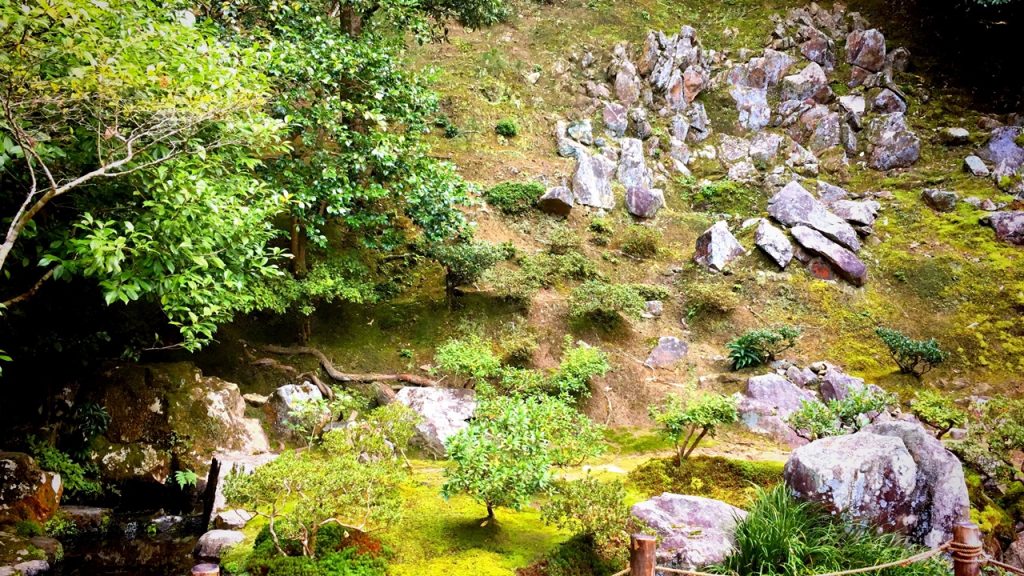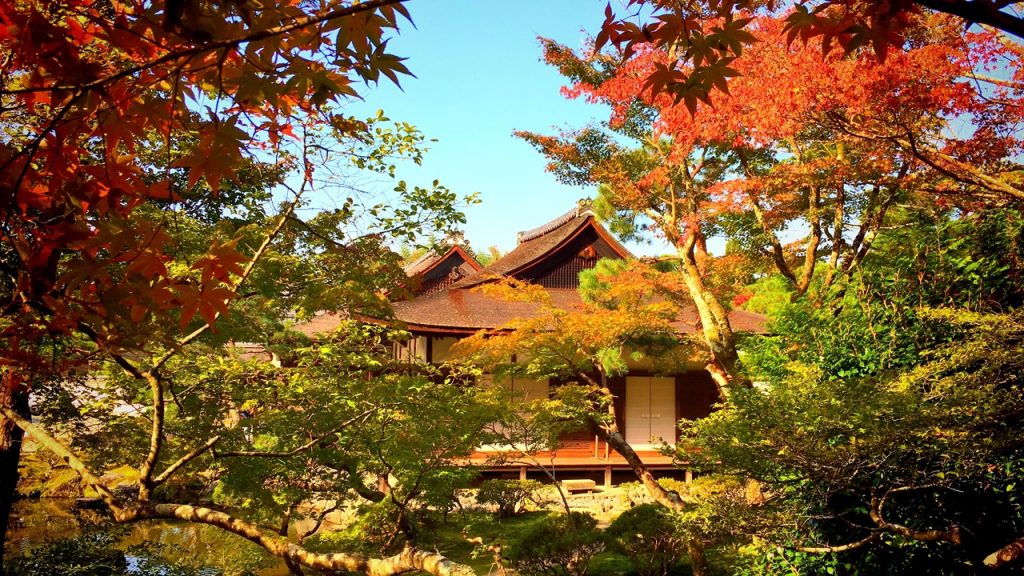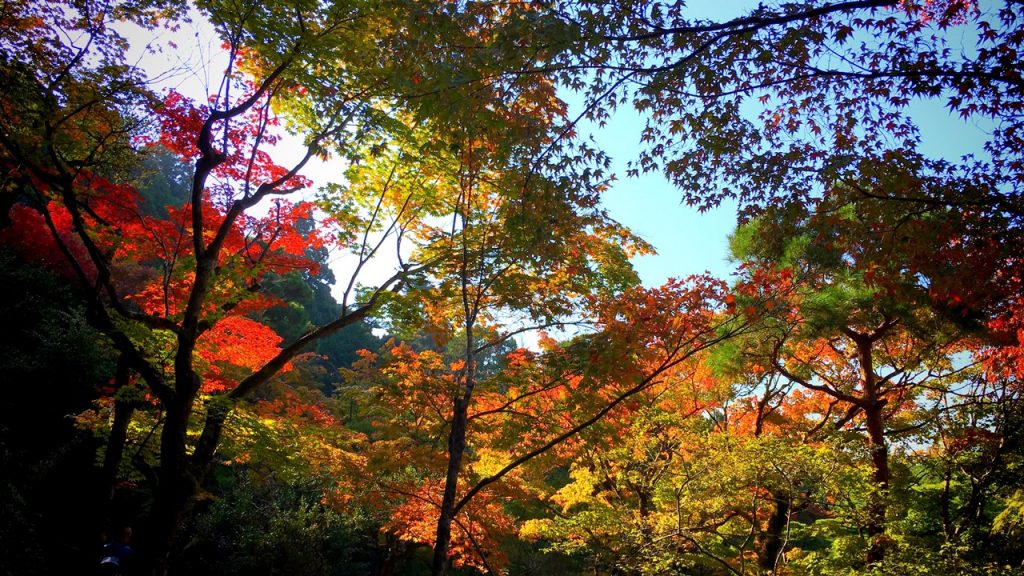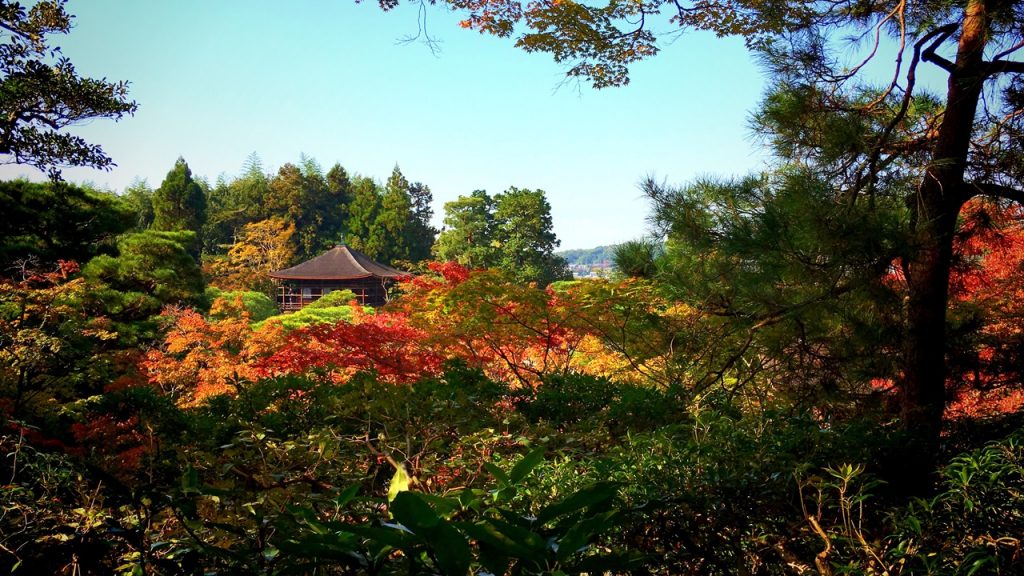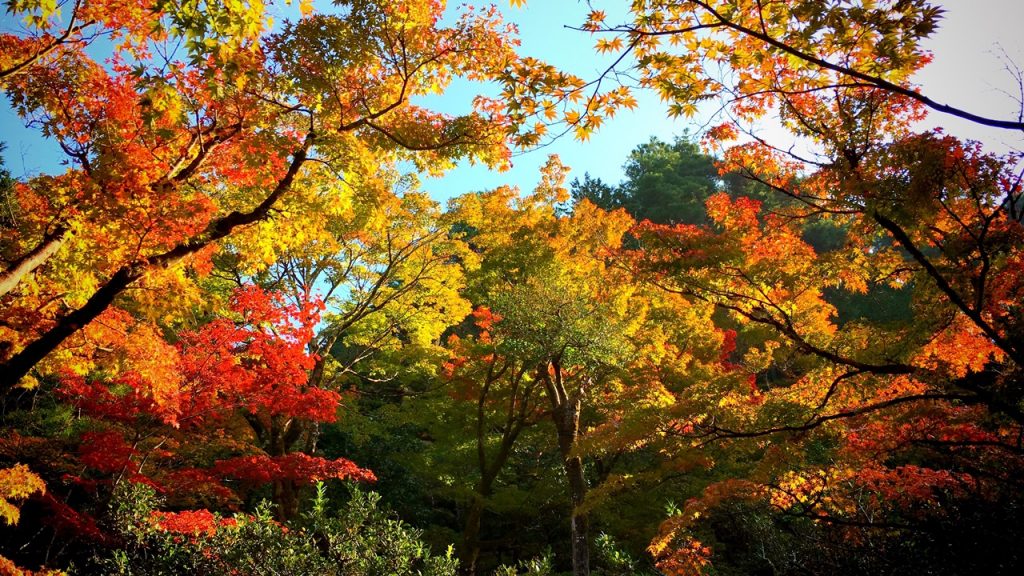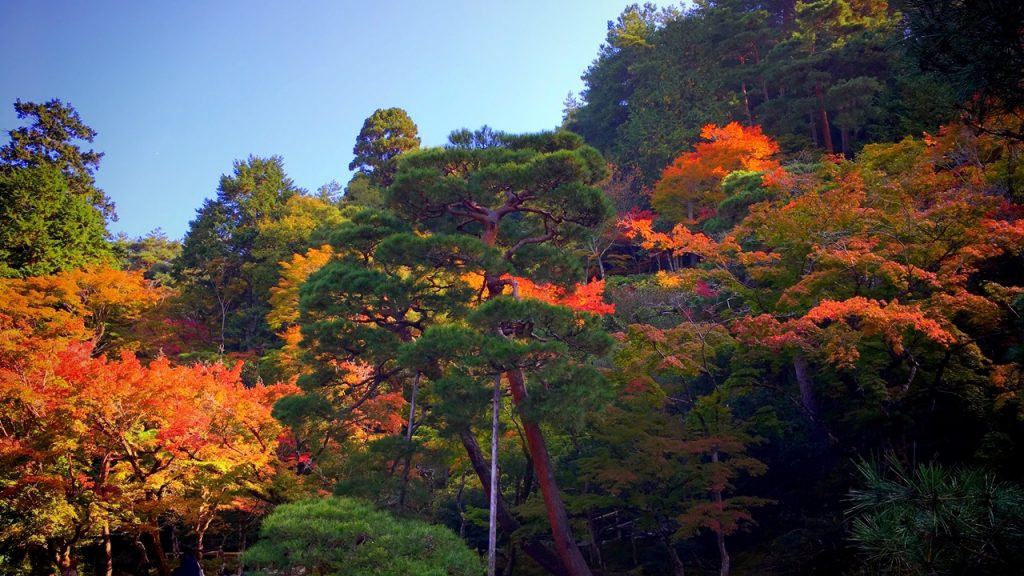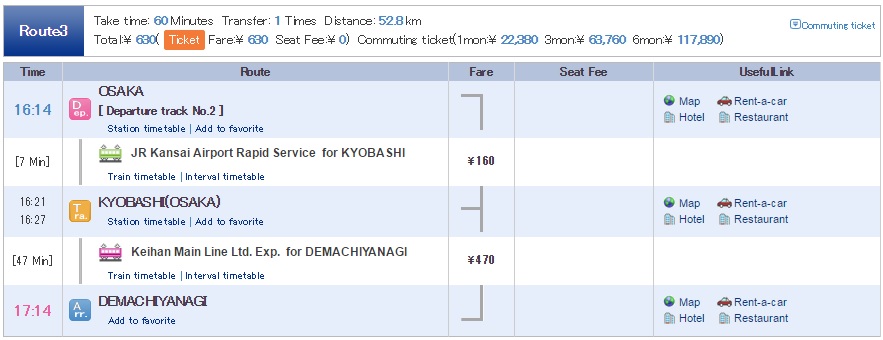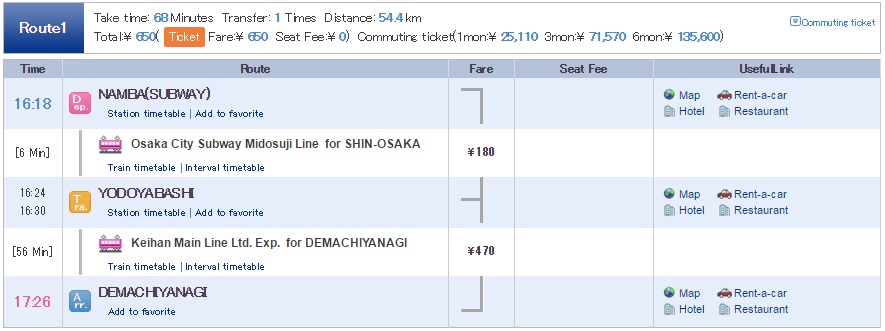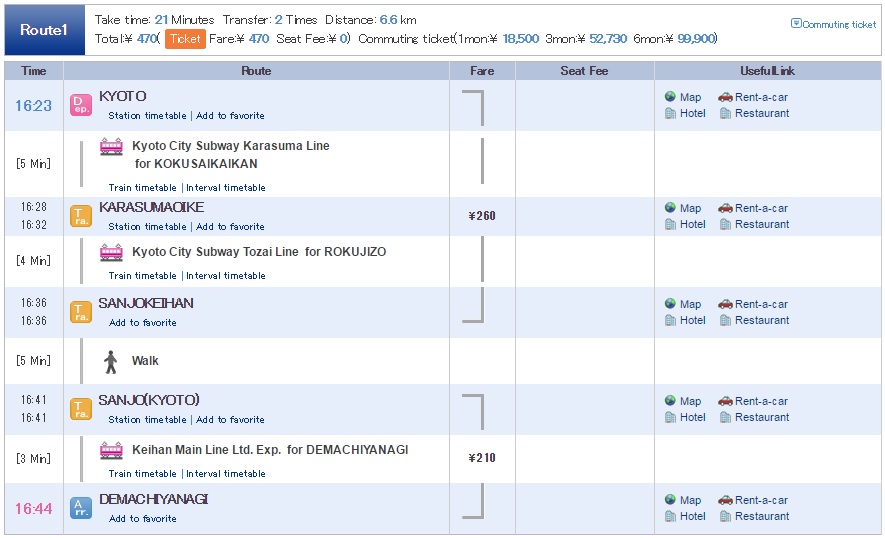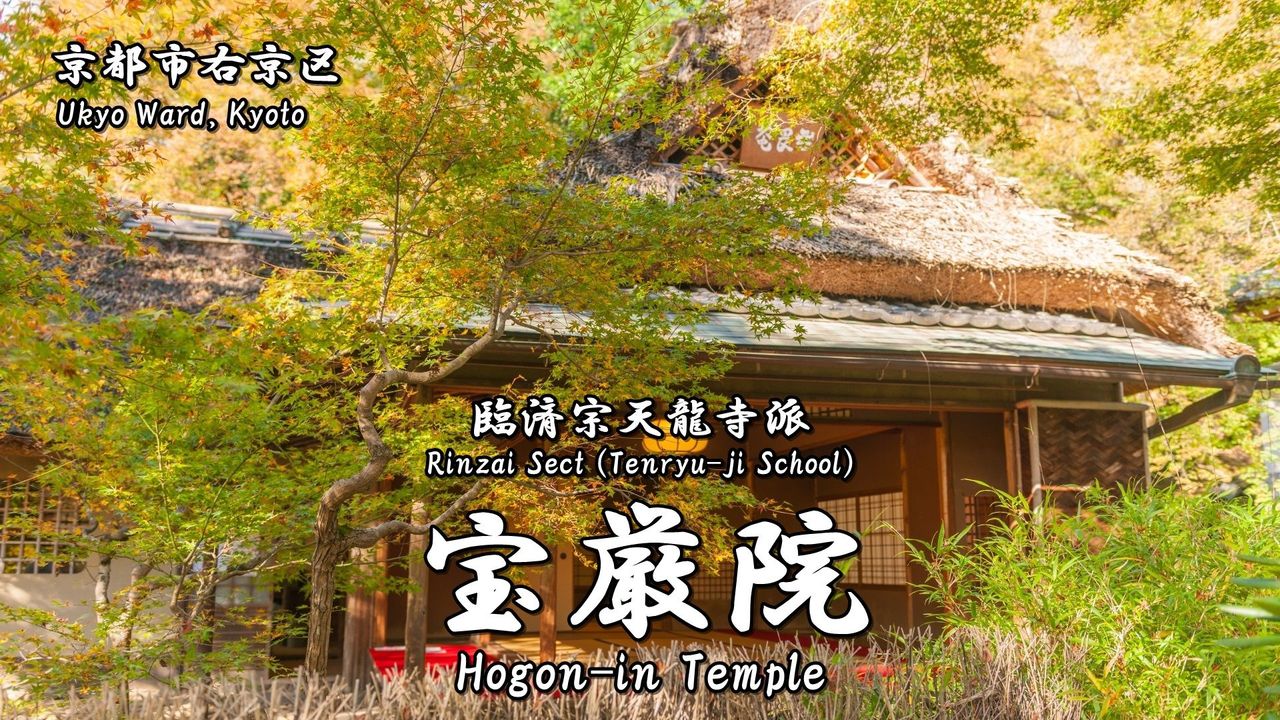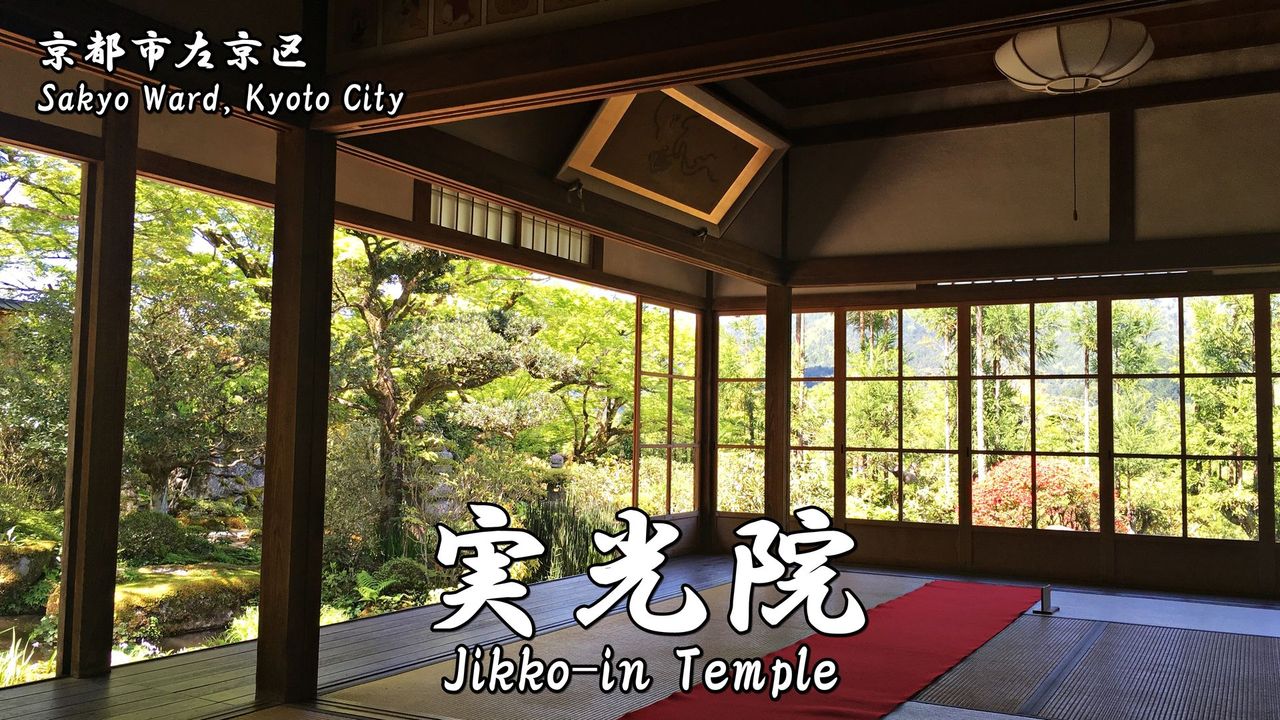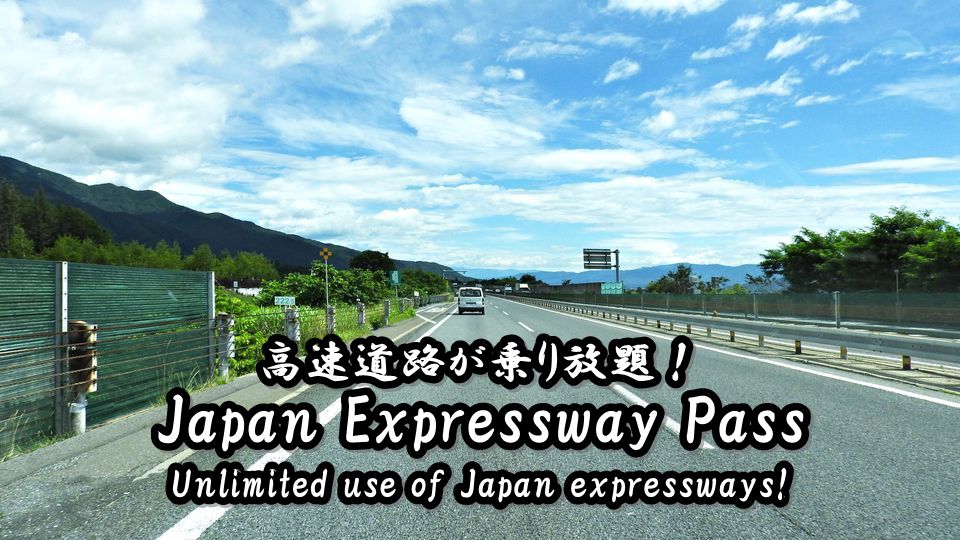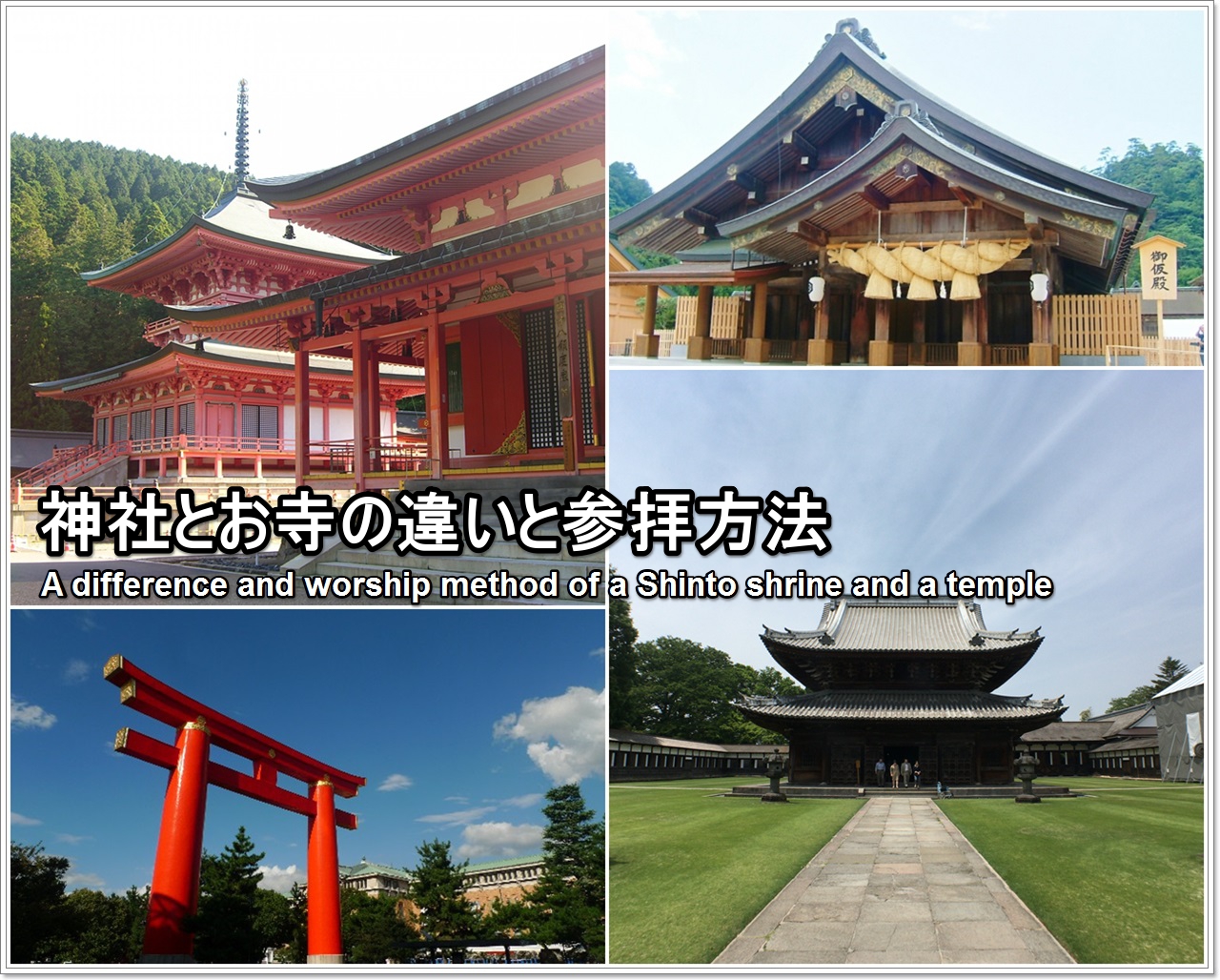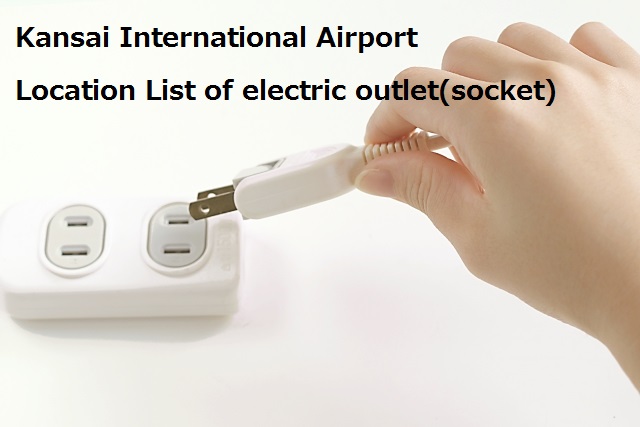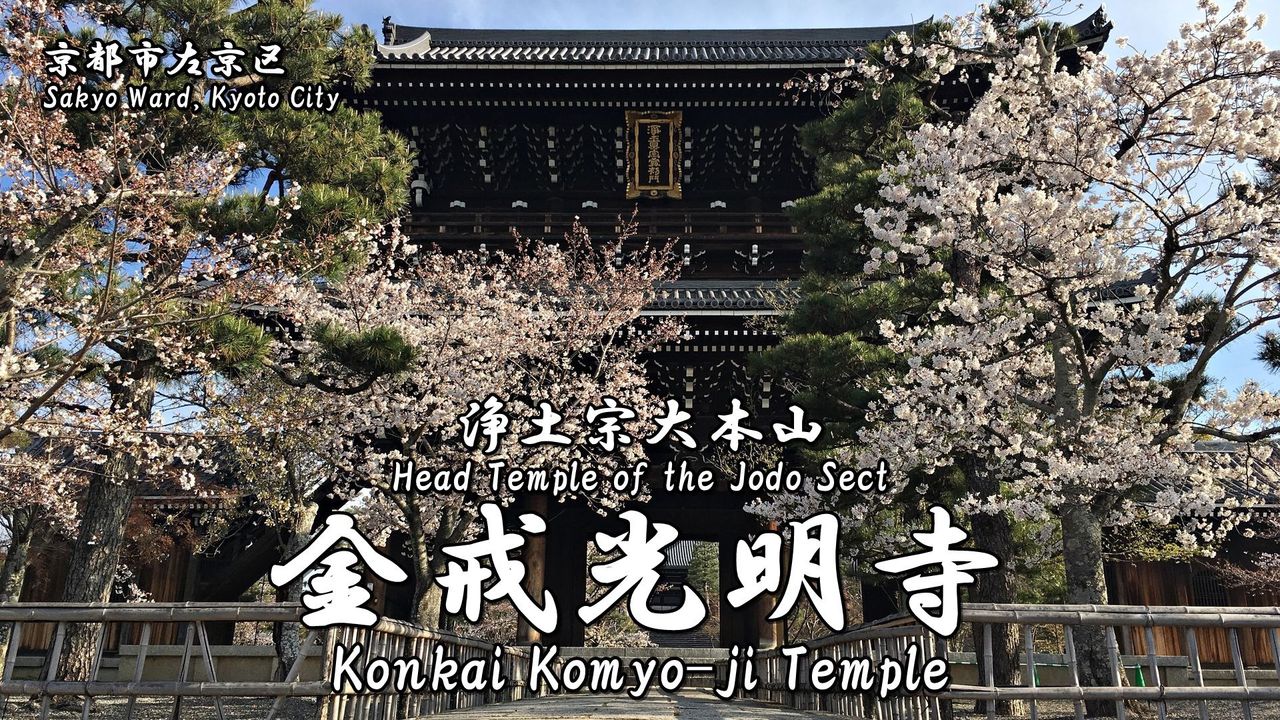Two distinct cultures flourished during the Muromachi period, the Kitayama culture of Yoshimitsu’s day and the Higashiyama culture of Yoshimasa’s time.
In contrast to the lavish Kitayama culture represented by Kinkaku from the 3rd Shogun Yoshimitsu’s era, the culture of this period is called “Higashiyama culture” that emphasizes wabi-sabi (simplicity and quietude) as represented by Ginkaku.
Ginkaku-ji Temple (Higashiyama Jisho-ji Temple) is a typical temple of “Higashiyama culture” that emphasizes wabi-sabi (simplicity and quietude).
And this temple has been designated as the Michelin green guide ★★★ and the World Heritage List as part of the cultural assets of ancient capital of Kyoto.
Contents:
- About World Heritage ‘Historic Monuments of Ancient Kyoto’
- Difference between Kinkaku-ji (Kitayama Culture) and Ginkaku-ji (Higashiyama Culture)
- About Ginkaku-ji Temple
- Highlights of Ginkaku-ji Temple
- Autumn leaves of Ginkaku-ji Temple
- Goshuin of Ginkaku-ji Temple
- How to get to Ginkaku-ji Temple
1.About World Heritage ‘Historic Monuments of Ancient Kyoto’
17 places of temples and shrines of Kyoto are designated in ‘Historic Monuments of Ancient Kyoto’.
↓Details of the “Historic Monuments of Ancient Kyoto” is here.↓
Ginkaku-ji Temple has been designated as the World Heritage List as part of the cultural assets of ancient capital of Kyoto.
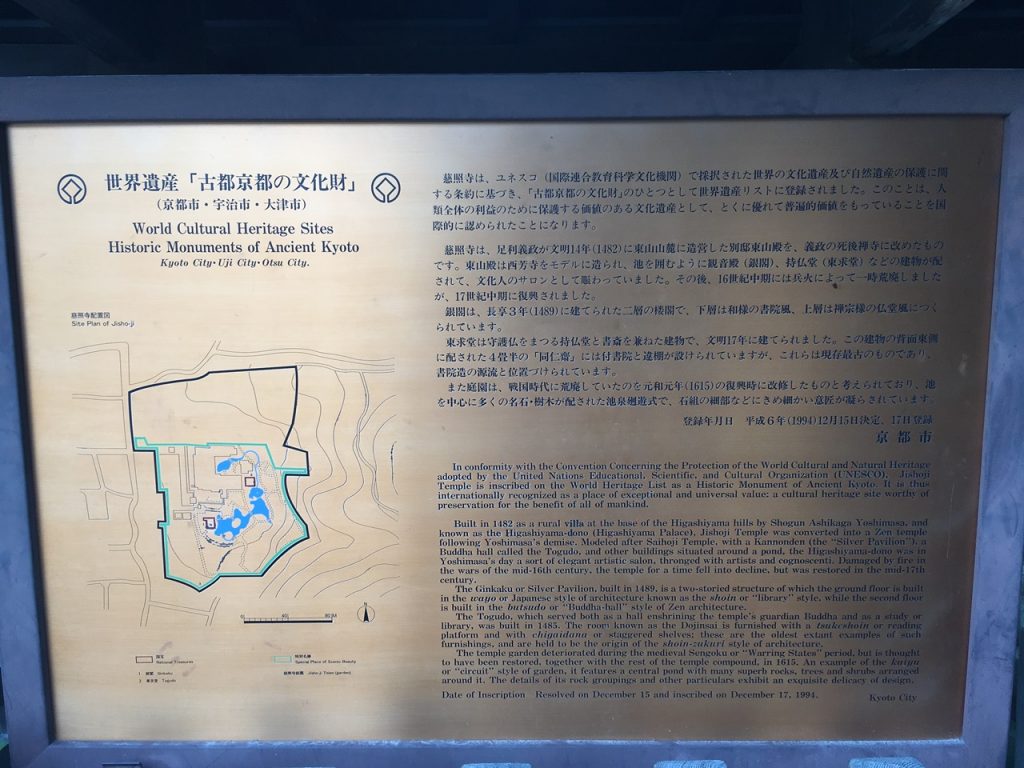
2.Difference between Kinkaku-ji (Kitayama Culture) and Ginkaku-ji (Higashiyama Culture)
Let’s study the Japanese history (Muromachi era) with me before introducing Ginkaku-ji Temple.
I think that we can enjoy sightseeing of Ginkaku-ji Temple still more by learning the history of Muromachi era.
Difference between Kinkaku-ji and Ginkaku-ji can be also called the difference between Kitayama culture and Higashiyama culture.
Kitayama culture and Higashiyama culture are the Japanese culture that prospered in the Muromachi era.
(Kitayama culture is the culture that prospered in the first half of the Muromachi era, and Higashiyama culture is the culture that prospered in the latter half of the Muromachi era.)
If I say difference in these culture in a word…
The Kitayama culture is gorgeous.
The Higashiyama culture is simplicity and quietude.
Why would culture change in the first half and the latter half of the Muromachi era?
It was caused by the Onin War.
The Onin War was a civil war that lasted from 1467 to 1477, during the Muromachi period in Japan.
And the stage of this civil war was Kyoto.
Therefore Kyoto suffered crushing damage in this war.
Therefore Japanese culture was changed before and after Onin War.
I summarized these differences in a list.
Please refer to it if interested.
3.About Ginkaku-ji Temple
Ginkaku-ji (銀閣寺?, lit. “Temple of the Silver Pavilion”), officially named Jishō-ji (慈照寺?, lit. “Temple of Shining Mercy”), is a Zen temple in the Sakyo ward of Kyoto, Japan. It is one of the constructions that represents the Higashiyama Culture of the Muromachi period.
引用(citation):https://en.wikipedia.org/wiki/Ginkaku-ji
Open:8:30~17:00(3/1~11/30), 9:00~16:30(12/1~2/27)
Admission Fee:500 yen(High school student or older),250 yen(Elementary / Junior high school student)
Address:2, Ginkakujicho, Sakyo-ku Kyoto-shi, Kyoto, 606-8402, Japan
Phone Number:+81-75-771-5725
Ginkaku-ji Temple (a sub-temple of Shokoku-ji Temple) is located in Sakyo Ward, Kyoto City, Kyoto Prefecture and is associated with the typically Higashiyama Bunka Rinzai sect Shokoku-ji School.
The principal image of this temple is Shaka Nyorai (Shakyamuni).

Its formal name is Higashiyama Jisho-ji Temple.
The Kannon-den Hall in this temple came to be called Ginkaku.
herefore, this temple came to be called Ginkaku-ji Temple gradually.
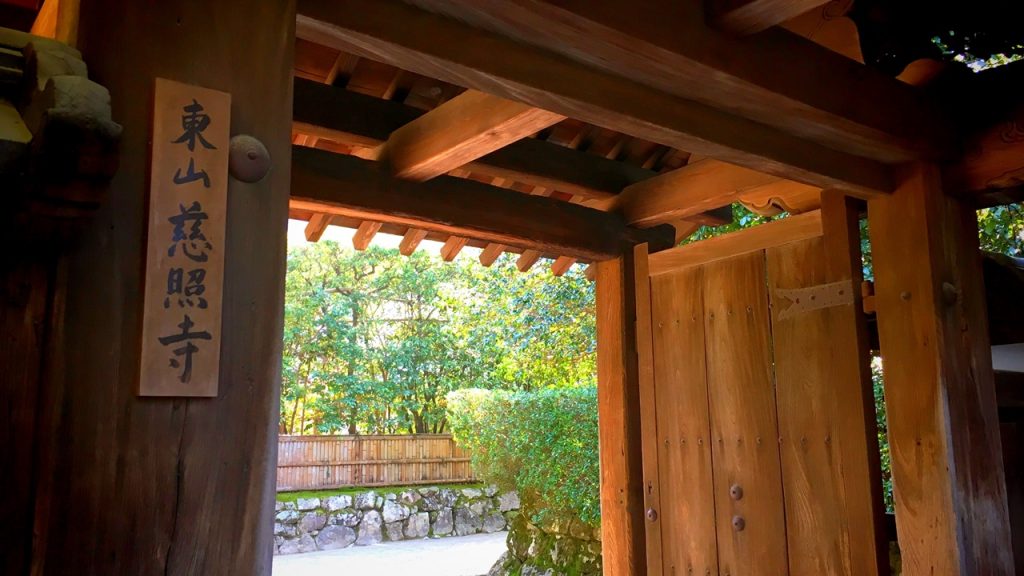
The garden of this temple has been designated as Special Historic Site and Special Place of Scenic Beauty.
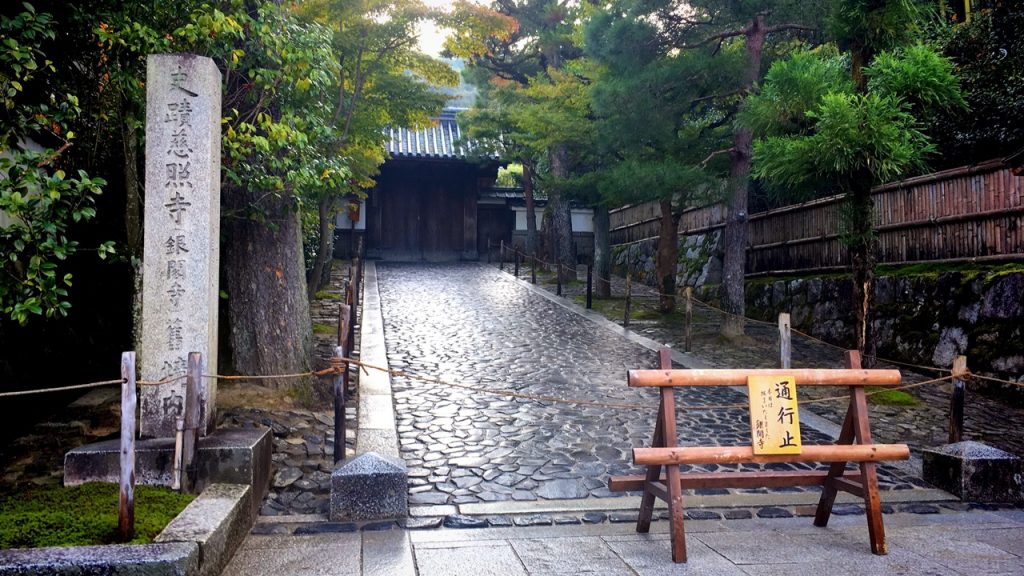
Ginkaku-ji Temple is one of the three sub-temples outside the Shokoku-ji Temple site, along with the Kinkaku-ji and Shinnyo-ji.
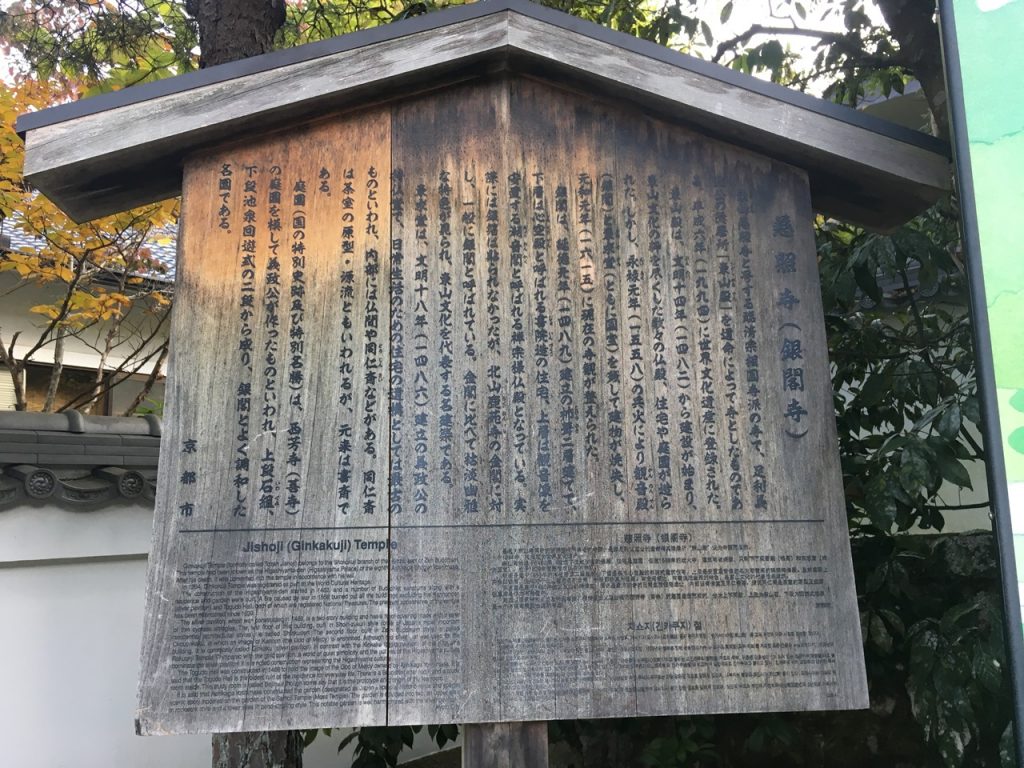
An admission fee is 500 yen (High school student or older).

Next, let’s watch the highlight of Ginkaku-ji Temple!!

4.Highlights of Ginkaku-ji Temple
- 総門:(Somon gate (Main gate))
- 銀閣寺垣:(Ginkaku-ji fencing)
- 中門:(Chumon gate)
- 庫裏:(Kuri (monks’ living quarters))
- 宝処関:(Hoshokan gate)
- 観音殿(銀閣)(国宝):(Kannon-den Hall(Ginkaku)) (National Treasure)
- 八幡社:(Hachiman Shrine)
- 向月台:(Kogetsudai)
- 本堂:(Hondo (Main temple))
- 銀沙灘:(Ginshadan)
- 東求堂(国宝):(Togu-do Hall) (National Treasure)
- 洗月泉:(Sengetsusen Waterfall)
- 白鶴島:(Hakkakuto island)
- 弁財天:(Benzaiten Shrine)
- お茶の井:(Ochanoi)
- 漱蘚亭跡:(Sosen-tei Vestige)
- 月待山展望所:(Tsukimachiyama Hill)
●総門:(Somon gate (Main gate))
This is Somon gate (Main gate) which is an entrance of Ginkaku-ji Temple.
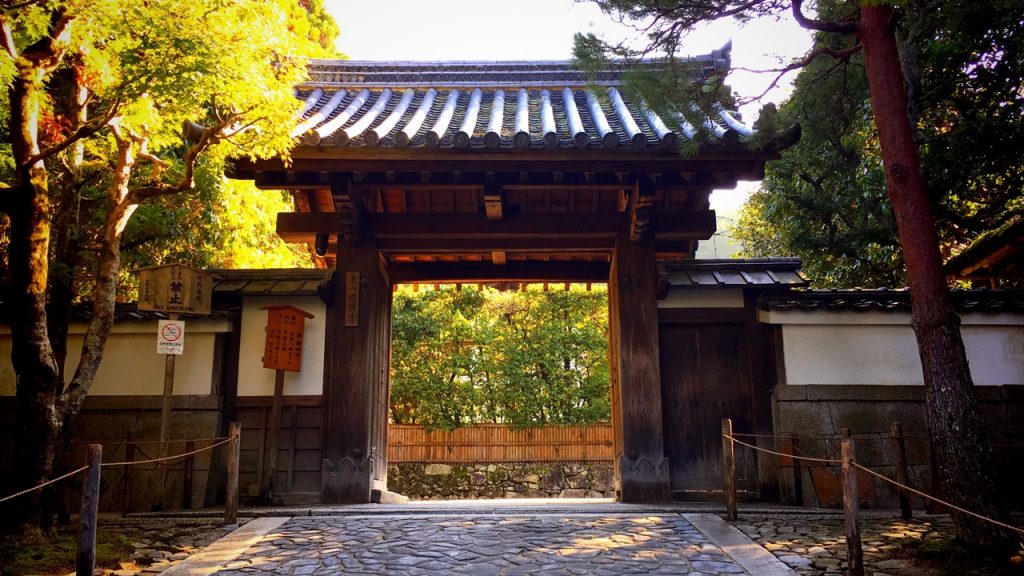
●銀閣寺垣:(Ginkaku-ji fencing)
The entrance pathway between the main gate and inner garden is lined with a distinctive fencing that has come to be known as Ginkaku-ji fencing (ginkaku-ji gaki).
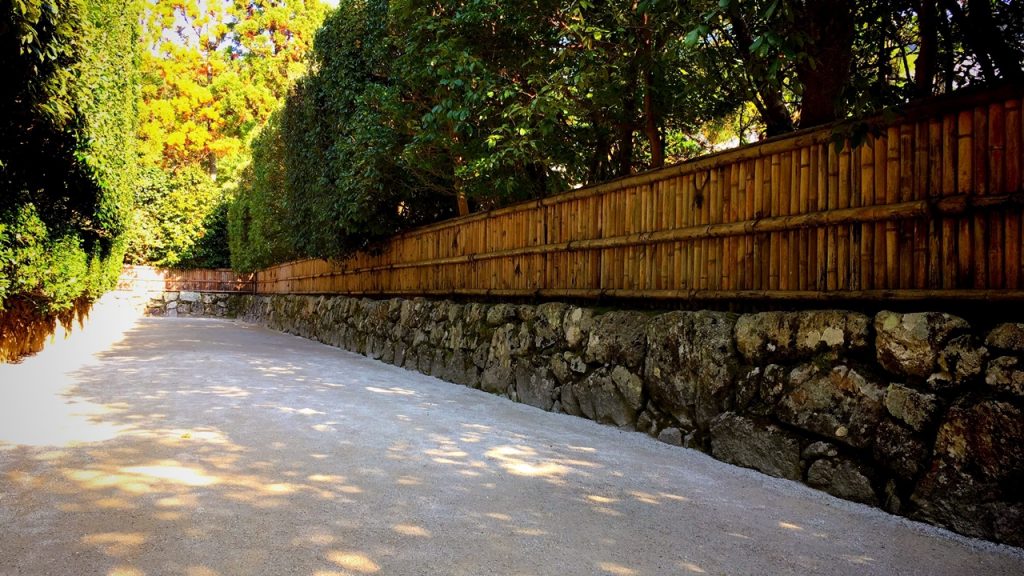
●中門:(Chumon gate)
This is Chumon gate which is the entrance to the pay area.
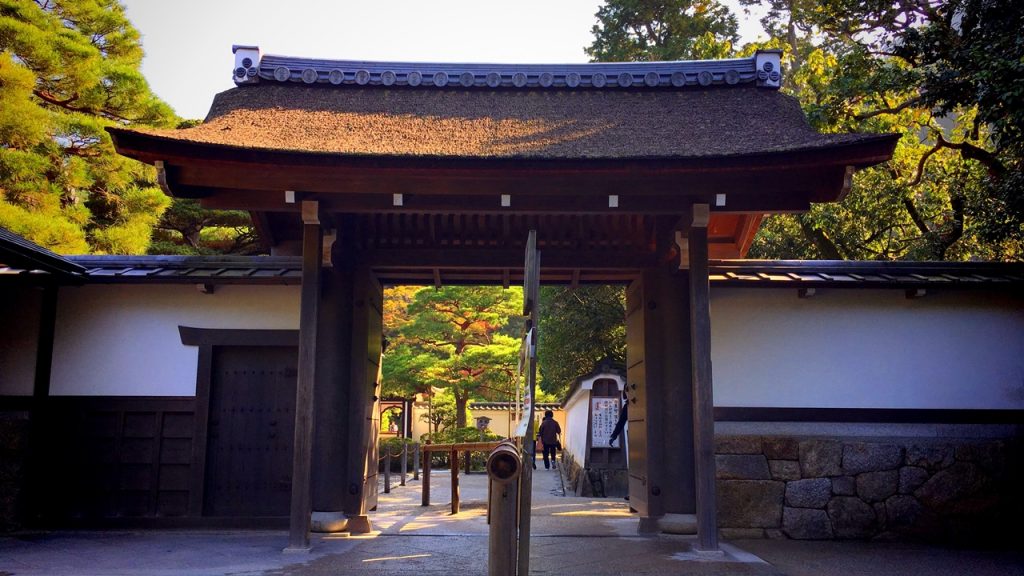
●庫裏:(Kuri (monks’ living quarters))
This building is Kuri (monks’ living quarters).
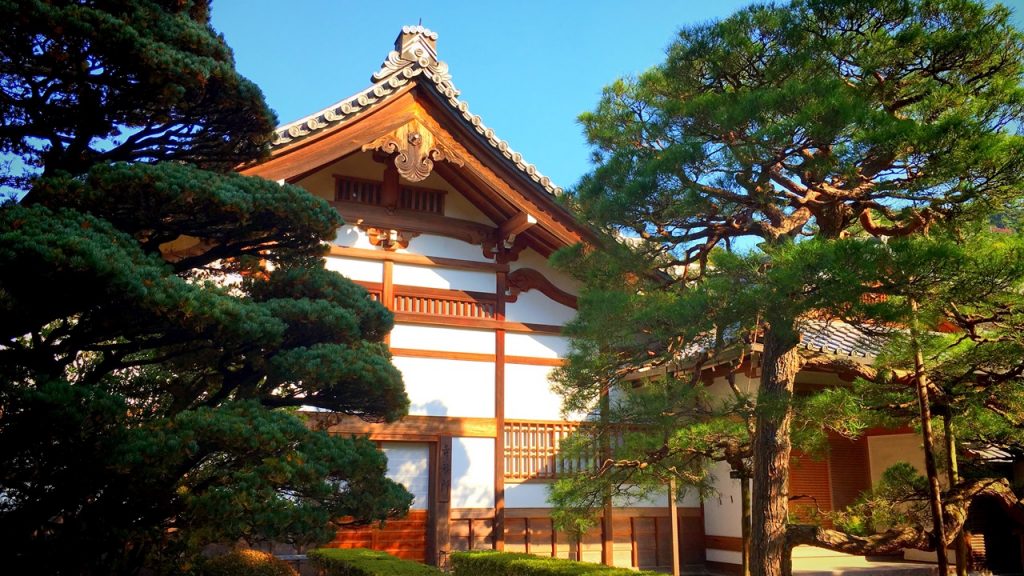
The front yard of the Kuri is a sand garden which is maintained very neatly.

●宝処関:(Hoshokan gate)
This is Hoshokan gate.
There is this gate in the border of the outside and the precincts.
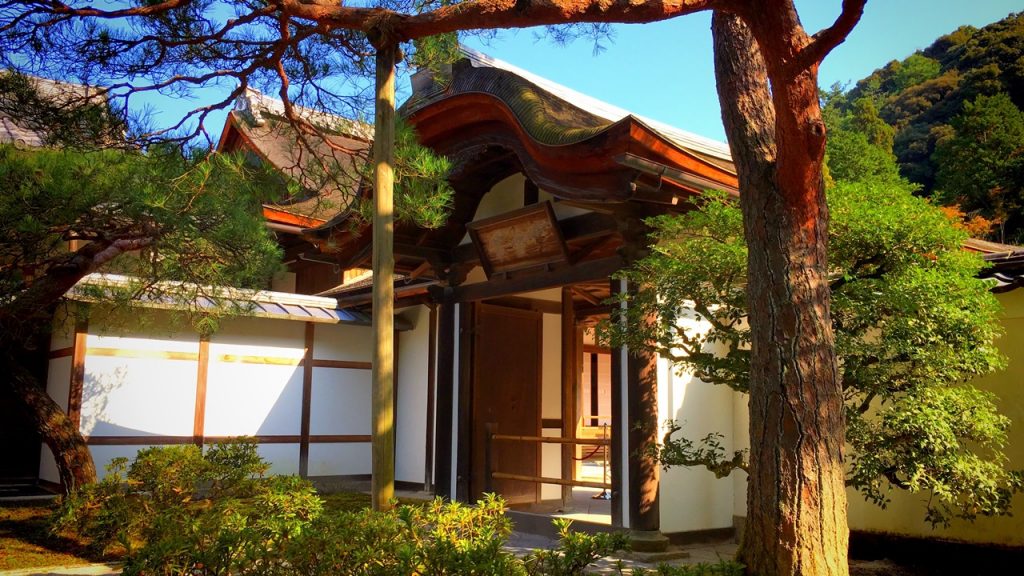
●観音殿(銀閣)(国宝):(Kannon-den Hall(Ginkaku)) (National Treasure)
This is Kannon-den Hall(Ginkaku) which is the symbol of this temple.
The image of the phoenix is displayed on the roof of Kannon-den Hall(Ginkaku).
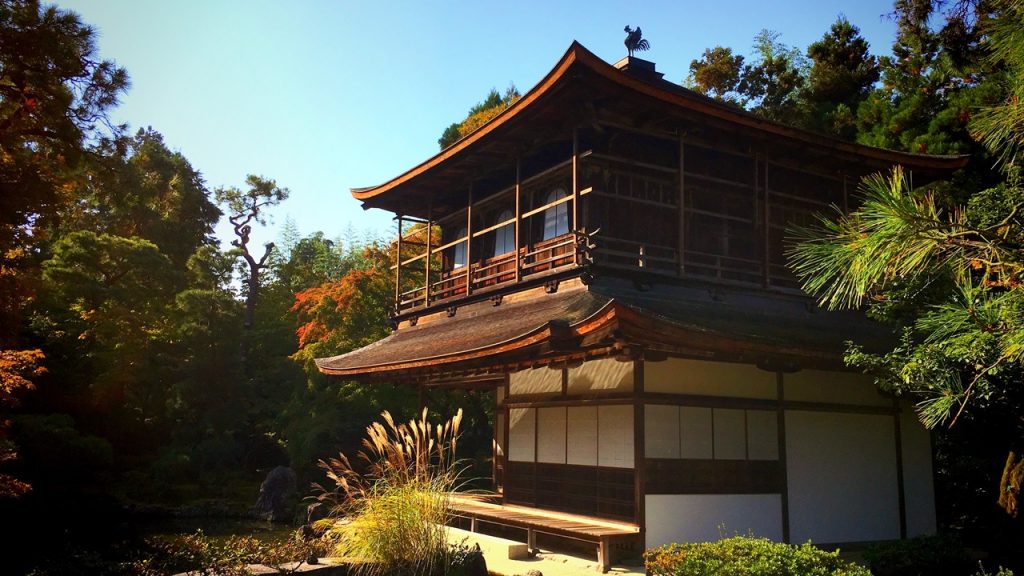
This building is a wooden 2-story lofty (Rokaku) building.
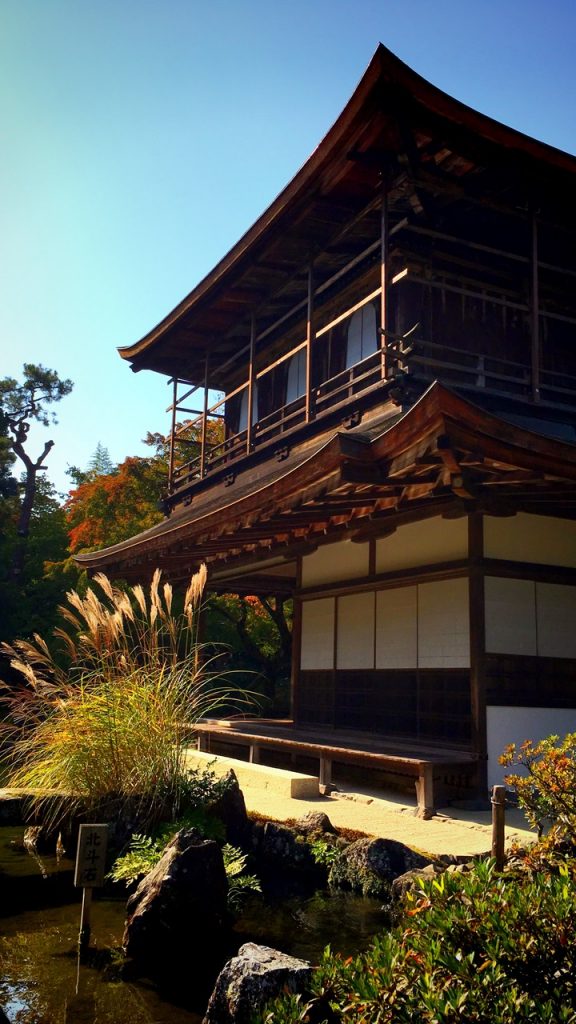
The pond before Kannon-den Hall is called Kinkyochi pond.

This building built in 1489 has been designated as a national treasure.
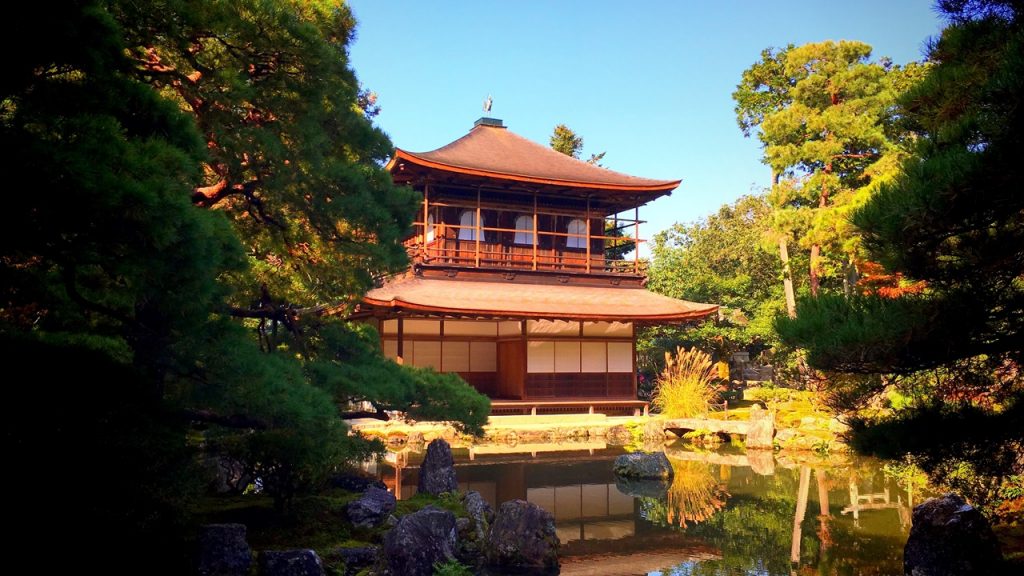
●八幡社:(Hachiman Shrine)
This is Hachiman Shrine which is built beside Kannon-den Hall.
This is the Chinju (local Shinto deity) of Ginkaku-ji Temple.
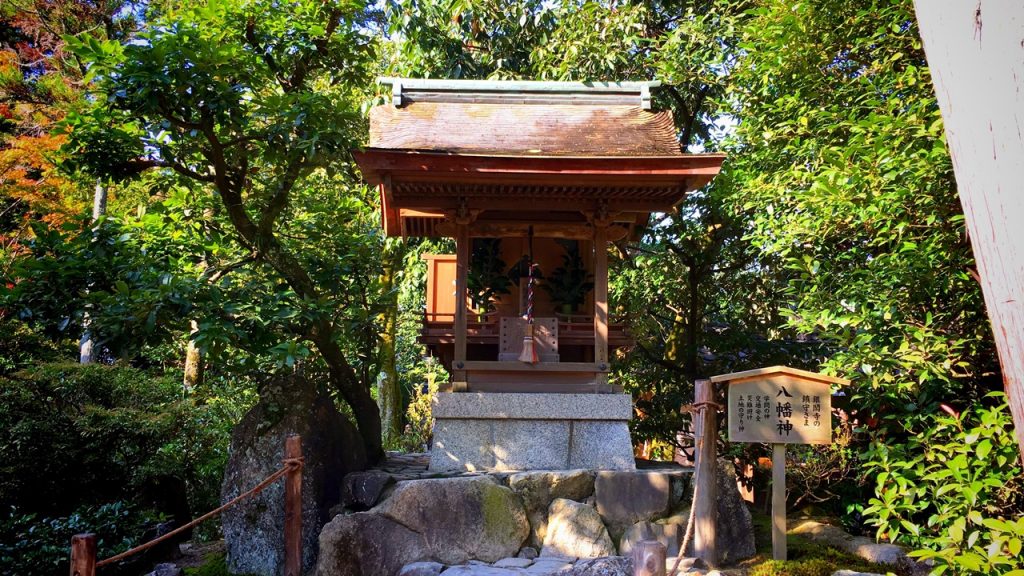
●向月台:(Kogetsudai)
This is the pile of sand called “Kogetsudai“.
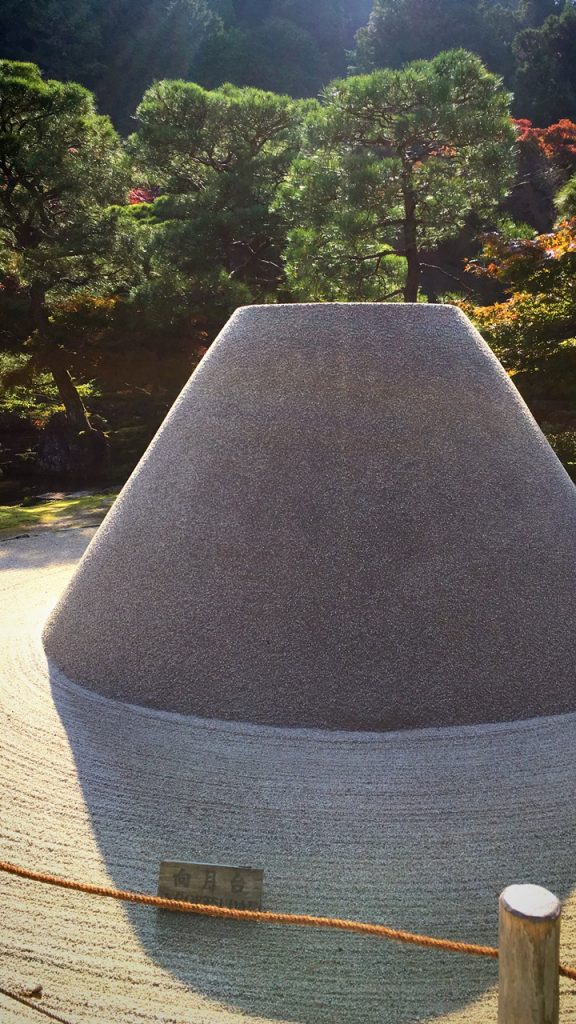
This object has height of approximately 180cm, and it is said to be the place that waits for the moon to rise.
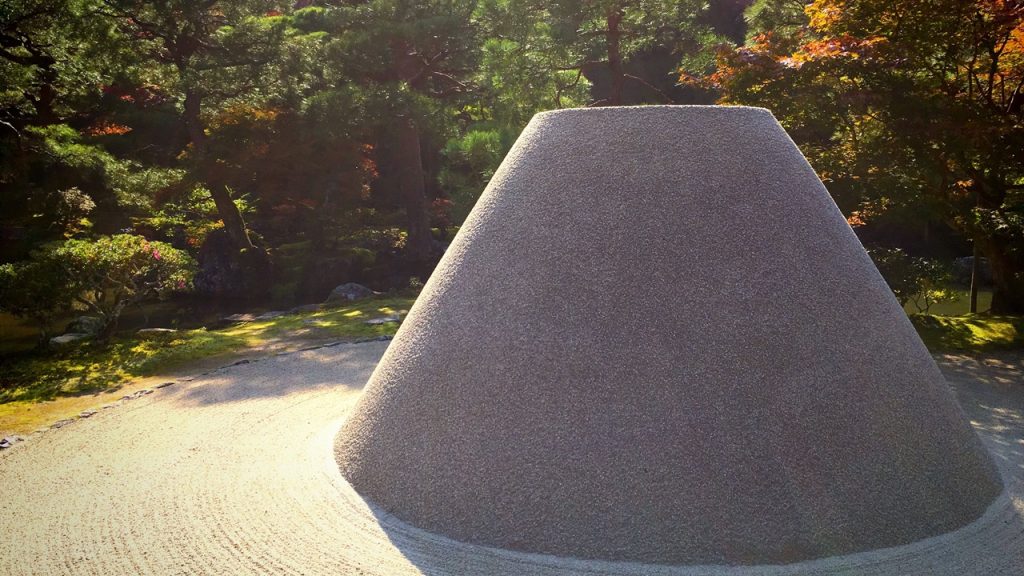
●本堂:(Hondo (Main temple))
This is a building which was built early in the Edo era, and Shaka Nyorai who is the principal idol of this temple is enshrined.
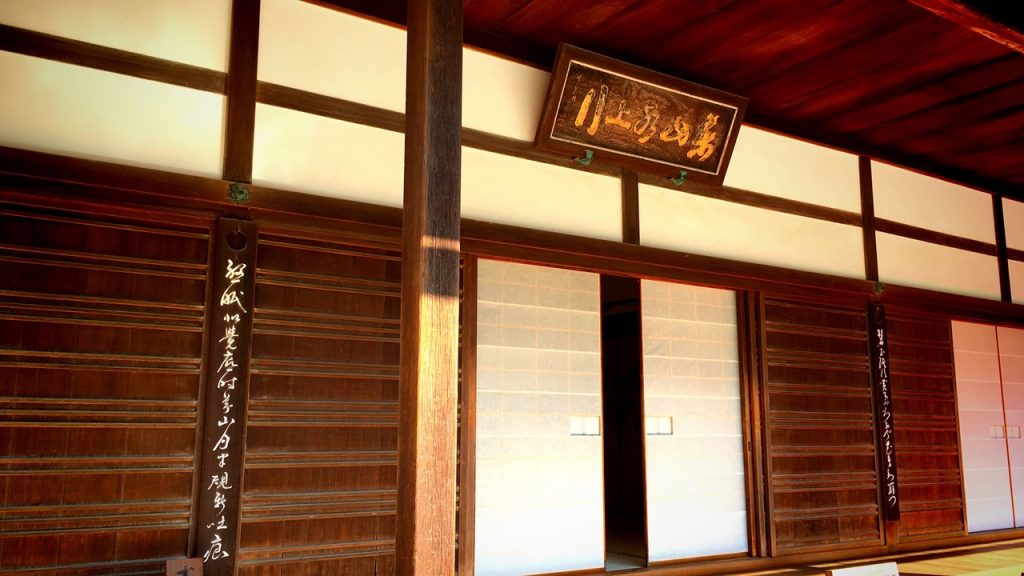
●銀沙灘:(Ginshadan)
This is the pile of sand called “Ginshadan“.
It is said that this sand garden expresses Saiko lake of China.
And the design of the sand expresses the wave of the lake.
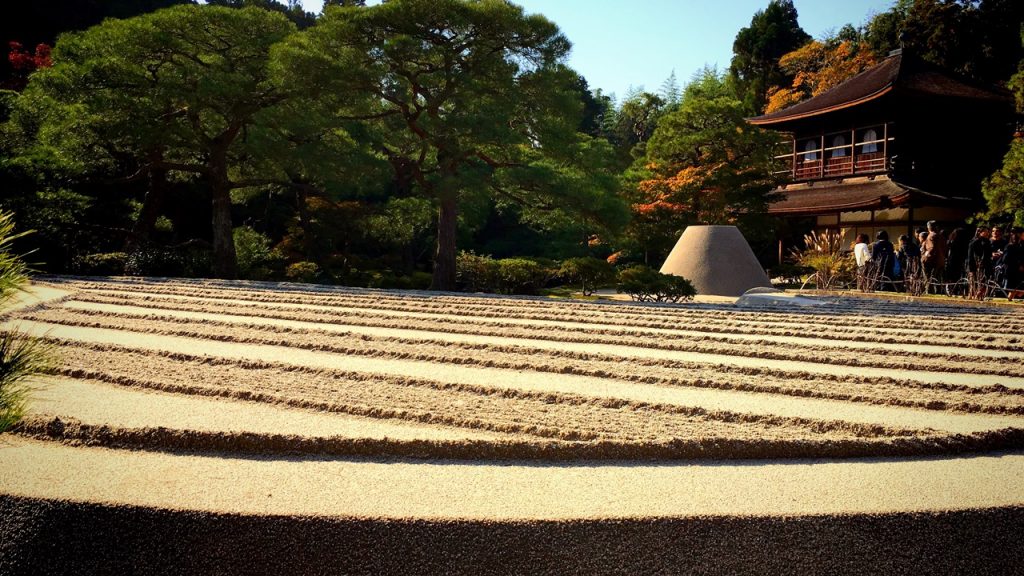
●東求堂(国宝):(Togu-do Hall) (National Treasure)
This building is Togu-do Hall of a national treasure which was built in 1486.
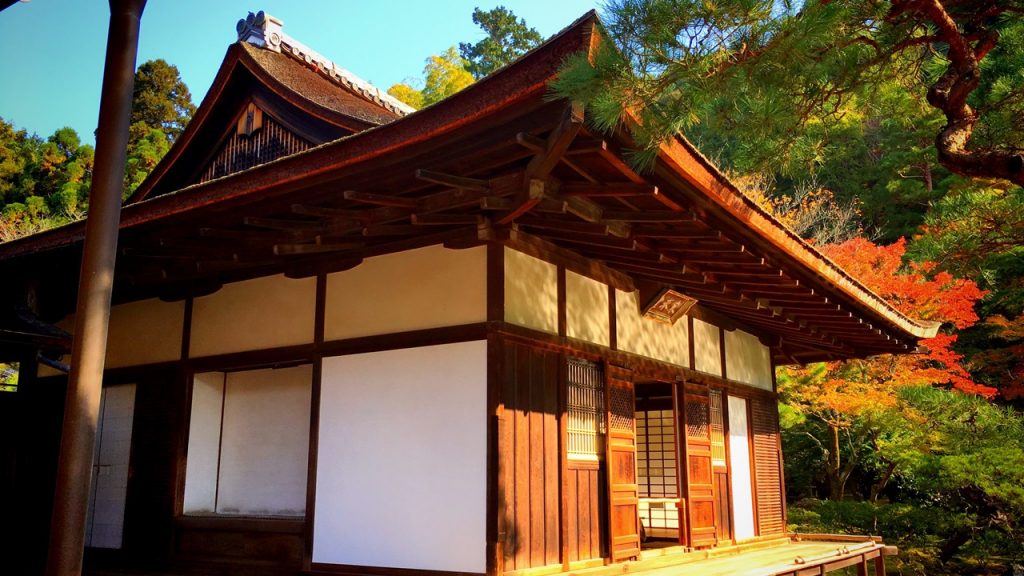
An image of Yoshimasa Ashikaga who is the initiator of this temple and Amitabha are enshrined in this building.
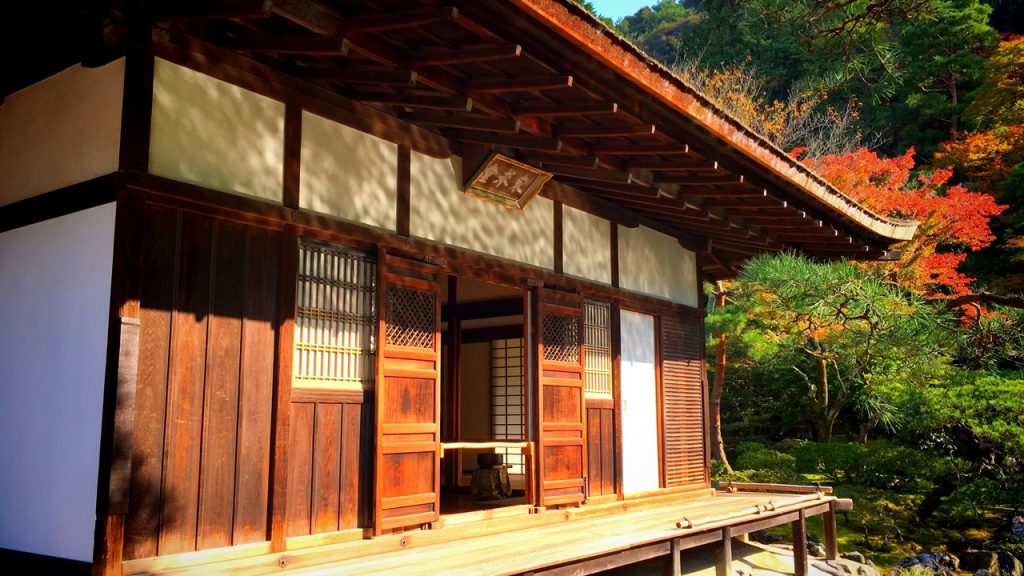
●洗月泉:(Sengetsusen Waterfall)
This is a small waterfall called Sengetsusen Waterfall.
It is said that a wish comes true if we can put the coin on the small stone which is in the left side of this photograph.
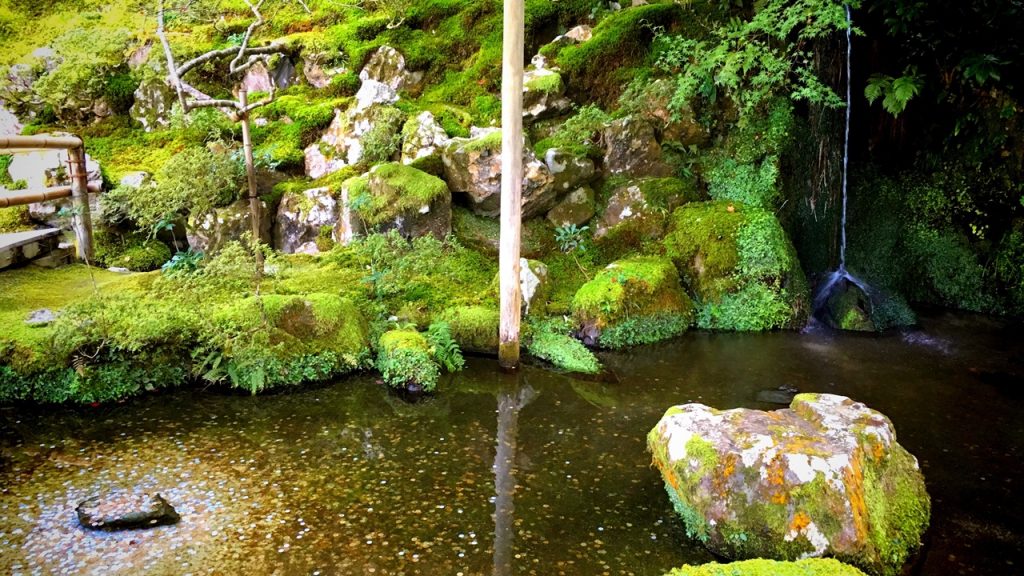
●白鶴島:(Hakkakuto island)
This island which is in front of Togu-do Hall is called Hakkakuto Island.
This is because the form of this island has a shape of the crane.
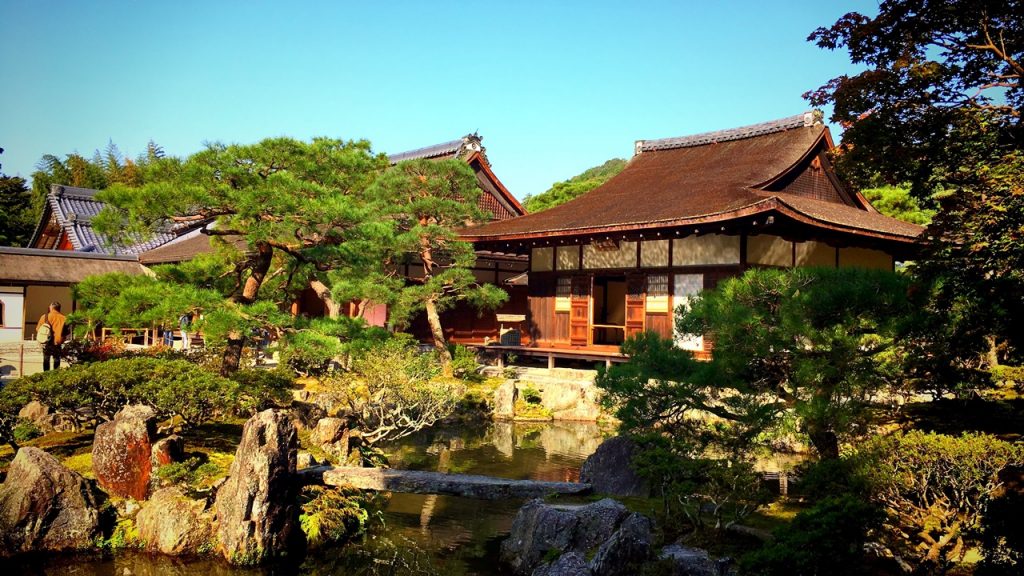
●弁財天:(Benzaiten Shrine)
This is the small Shinto shrine where Benzaiten (Sarasvati) is enshrined.
The Sarasvati is known as God of the arts and sciences.
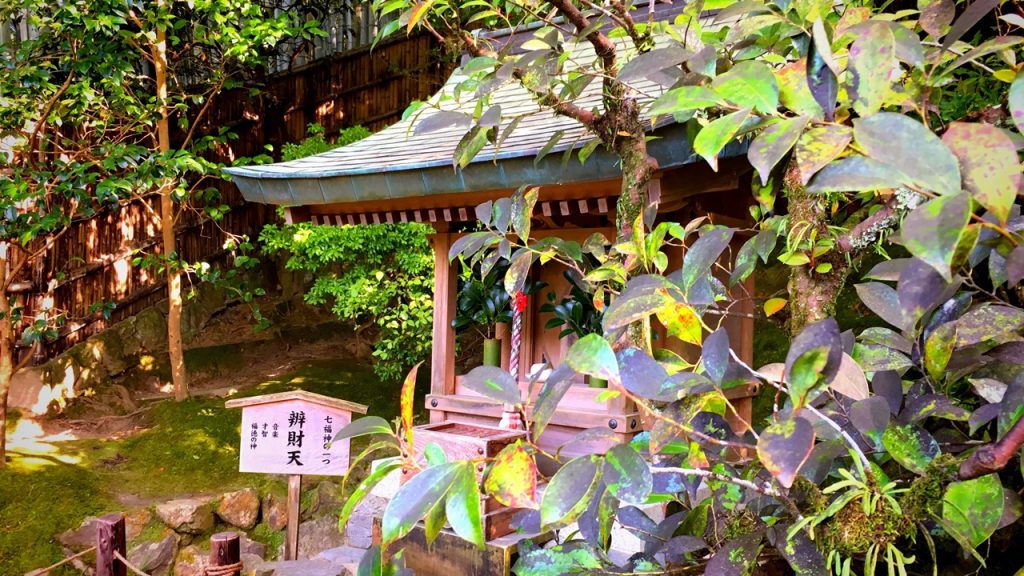
●お茶の井:(Ochanoi)
This is a spring water called Ochanoi which is in the depths of the precincts.
It is said that Yoshimasa Ashikaga enjoyed a tea break with this water in the old days.
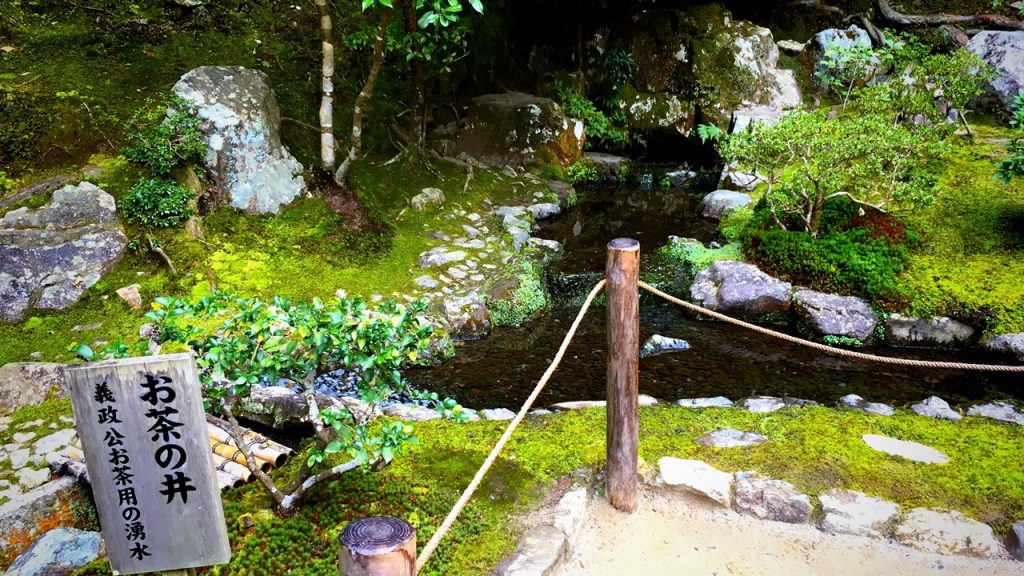
●漱蘚亭跡:(Sosen-tei Vestige)
●月待山展望所:(Tsukimachiyama Hill)
There is an observation platform in the depths of the precincts of Ginkaku-ji Temple.

We can overlook Ginkaku-ji Temple from here. (○´艸`)
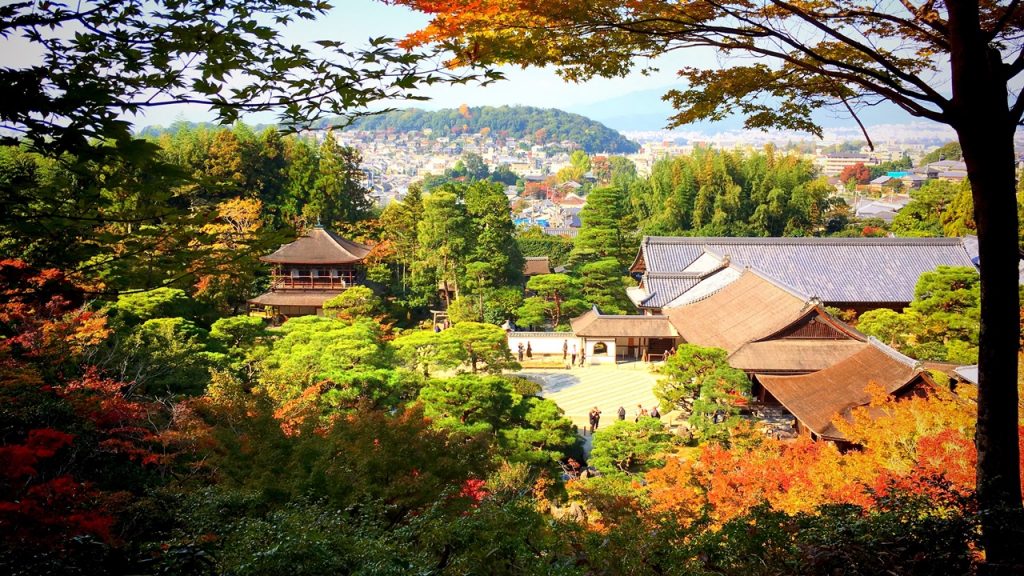
We can look down at all the buildings in Ginkaku-ji Temple.
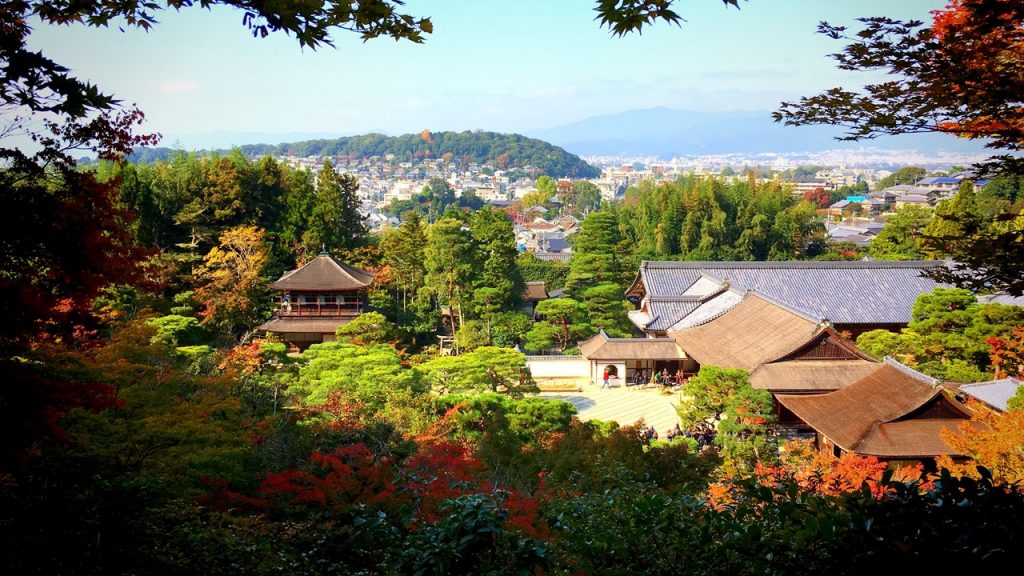
5.Autumn leaves of Ginkaku-ji Temple
Many maple trees are planted in the precincts of Ginkaku-ji Temple.
Therefore, the whole temple turns red in autumn.
Late November is the best time to see autumn leaves here.
6.Goshuin of Ginkaku-ji Temple
This Temple’s Sumigaki(The words which was written with a sumi(black ink)) is “観音殿(Kannon-den Hall)” which is the symbol of this temple.
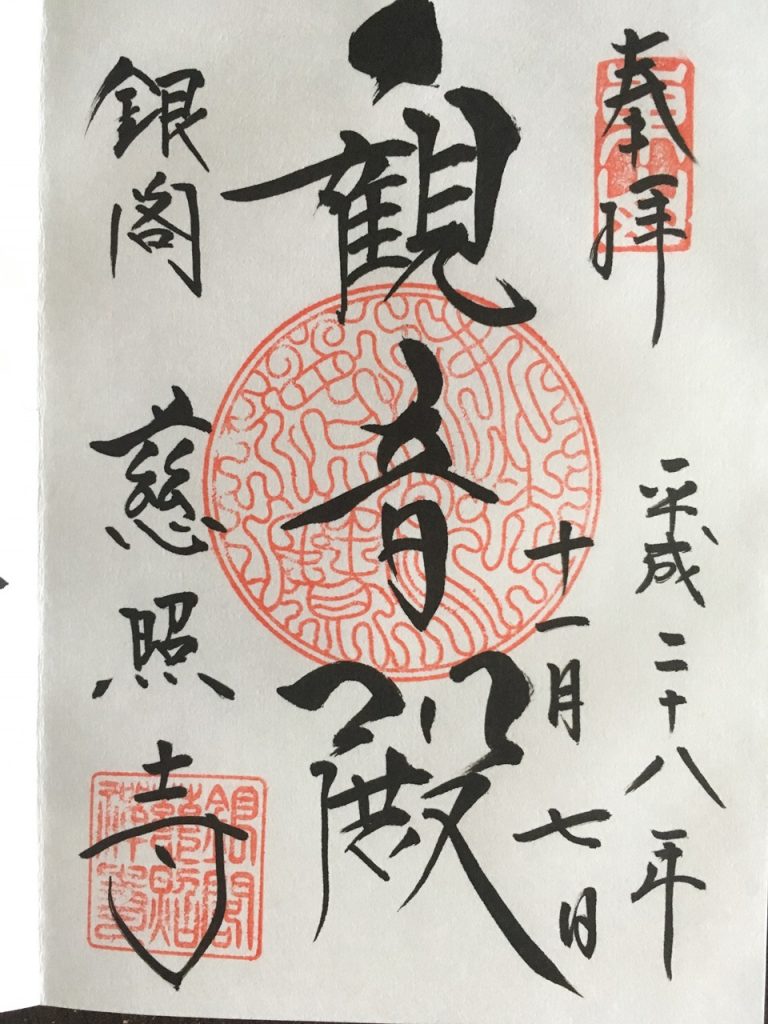
7.How to get to Ginkaku-ji Temple
The nearest station of Ginkaku-ji Temple is “Keihan Demachiyanagi station”.
(We can go by bus from “Keihan Demachiyanagi Station”, “Hankyu Kawaramachi Station” and “Subway Kokusaikaikan Station”.)
■Keihan Demachiyanagi Station→Ginkaku-ji Temple
We can go by bus or on foot.
(It’s about 45 minutes from Demachiyanagi station to Ginkaku-ji Temple on foot. Therefore I recommend that you go by bus.)
■In the case of on foot
It’s about 45 minutes (2.5km) from Demachiyanagi station to Ginkaku-ji Temple on foot.
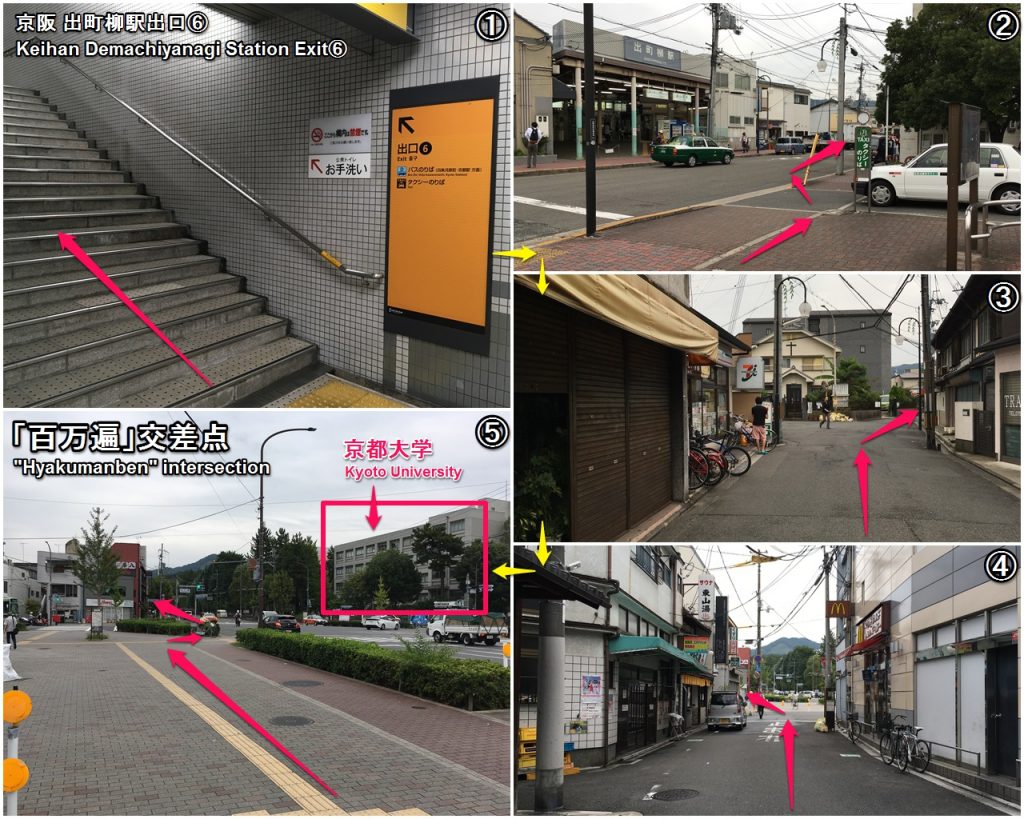
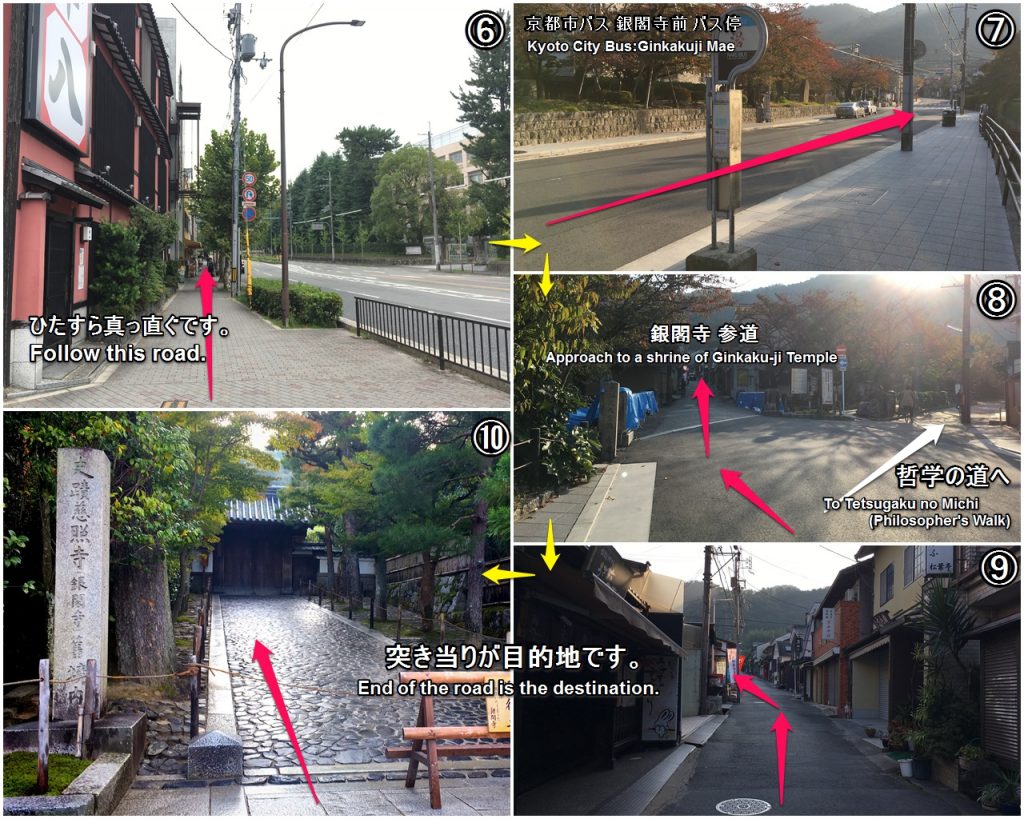
■In the case of bus
Timetable and Route Search of bus
①When you get on a bus from Keihan Demachiyanagi Station
[Timetable]
Route No.203
Route No.17
Bus company:Kyoto City Bus
Routes/Destination:17/203(Bound for Ginkakuji Temple)
Boarding bus stop:Demachiyanagi Sta.
Alighting bus stop:Ginkakuji Michi or Ginkakuji Mae
Bus fare:230 yen
Time required:About 10 min
②When you get on a bus from Hankyu Kawaramachi Station
[Timetable]
Route No.5
Route No.32
Bus company:Kyoto City Bus
Routes/Destination:5/32(Bound for Ginkakuji Temple/Iwakura/Heian-jingu)
Boarding bus stop:Shijo Kawaramachi [H]
Alighting bus stop:Ginkakuji Michi or Ginkakuji Mae
Bus fare:230 yen
Time required:About 20 min
③When you get on a bus from JR Kyoto Station
[Timetable]
Route No.5
Route No.100
Bus company:Kyoto City Bus
Routes/Destination:5/100(Bound for Ginkakuji Temple/Iwakura)
Boarding bus stop:Kyoto Sta. [A1]or[D1]
Alighting bus stop:Ginkakuji Michi or Ginkakuji Mae
Bus fare:230 yen
Time required:About 30 min
How did you like it?
Please try to go to this place.
Have a nice trip! XD
<Let’s search the sightseeing information of Kansai in Japan on ‘Japan’s Travel Manual‘!!>
<This site introduces the easiest way to get Japanese (Kansai) sightseeing spots to you.>

